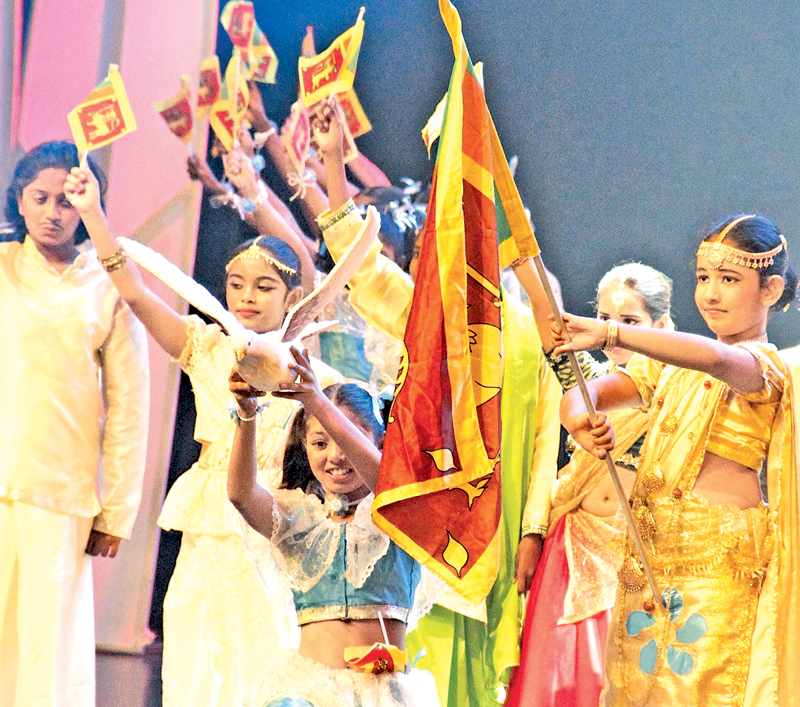Today is surely the best day to recall the words of Henry Ward Beecher.
“A thoughtful mind when it sees a nation's flag, sees not the flag, but the nation itself. And whatever may be its symbols, its insignia, he reads chiefly in the flag, the government, the principles, the truths, the history that belongs to the nation that sets it forth.”
As the national flag of Sri Lanka flutters with majestic grace in the soft breeze blown across the Indian ocean, representing our multicultural identity and our rich indigenous heritage on this, the 69th year since we gained independence from the British, it is with unlimited elation that we can raise our heads, gaze at our national flag and remind ourselves we are looking at a living piece of history and a source of pride and unity for all Sri Lankans. The lion, the orange and green stripes, the four bo leaves, all embody the very qualities that make our nation great. They are the symbols of justice, freedom, love of country and national pride that we as Sri Lankans pledge to honour.
Necessity of a National Flag
The story of our national flag dates back to the days before we gained independence. Toquote Nick Artimovich, an expert on vexillology as given in linkalibrary.com. “The necessity of a National Flag was discussed even before Sri Lanka gained independence on February 4th, 1948. Mr. A. Sinnalebbe, MP for Batticaloa tabled a motion in the State Council on January 16th, 1948 suggesting that the Lion Flag of King Sri Wickrama Rajasinghe which was taken to Britain in 1815 should be the National Flag. This was debated and later Prime Minister Rt. Hon. D.S. Senanayake named an Advisory Committee for the formulation of a National Flag. The Members of the Committee were Mr. S.W.R.D. Bandaranaike (Chairman), Sir John Kotalawela, Mr. J.R. Jayewardene, Mr. T.B. Jayah, Dr. L.A. Rajapakse, Mr. G.G. Ponnambalam and Senator S. Nadesan, and Dr. Senarath Paranavithana (Secretary).
“Although a Committee for the formulation of a national flag was appointed no finality had been reached when the first Independence Day was celebrated on February 4th, 1948. However, the Lion Flag fluttered on that day. The Lion Flag and the British Union Jack fluttered on the occasion of the opening of the first Parliament of independent Sri Lanka (then Ceylon) on February 11th, 1948. Prime Minister D.S. Senanayake unfurled the Lion Flag at the Octagon (Pattirippuwa) during the Independence celebrations held in Kandy on February 12, 1948.
Different versions
“I have seen two different versions of the flag adopted in February 1948,” continues Artimovich. “One is a yellow lion holding a sword in the right hand facing the hoist on a dark red background with four yellow silhouettes of a Buddhist pagoda in four corners with a yellow border and a black thin border inside. The other was exactly the same without the black thin border.”
Expanding this view, Carrol P Shaw writes in her book ‘Flags’, “Originally, the flag's central emblem was a gold lion and sword on a red field, derived from the flag of the Sinhalese kingdom of Kandy. As a consequence, it was not popular with the minority groups in the country, and so was amended in 1951 to include a green and orange band, to represent the Muslim and Tamil communities respectively. Finally, when the country adopted the local name of Sri Lanka in 1972, the flag was modified once more, with four leaves of the pipal (bo) tree, a Buddhist symbol, added to the four corners of the dark red panel. This version of the flag was in official use from 1978.”
Emblem of our freedom
Since then, this flag, which we honor today and will continue to honour for an uncountable number of independence days in the future, has been and will always be the emblem of our freedom, unity and purpose as a nation. It floats in majestic silence and yet, through this silence speaks to us, speaks to us of the past, of the men and women who went before us, and of the men and women who will precede us.
The flag of our nation has been through a great deal together with the people of our country and as long as it continues to flutter high above us in a cloudless blue sky there is hope of freedom and unity for Mother Lanka and all her children.
The significance of each symbol of the national flag is as follows:
* The lion in the flag represents the Sinhala race.
* The sword of the lion represents the sovereignty of the country.
* The noble eight fold path of Buddhism is signified by the lion's tail.
* Curly hair on the lion's head indicates religious observance, wisdom and meditation.
* The beard denotes purity of words.
* The handle of the sword highlights the elements of water, fire, air and earth.
* The nose indicates intelligence.
* The two front paws purport to purity in handling wealth.
* The vertical stripe of orange represent the minority Tamil race and the green vertical stripe the minority Muslim race.
* The four virtues of kindness: KINDNESS, FRIENDLINESS, HAPPINESS, EQUANIMITY are also represented in the flag.
* The border round the flag, which is yellow in color, represents other minor races.
* The bo-leaves at the four corners of the flag represent Buddhism and it's influence on the nation. They also stand for the four virtues - Kindness, Friendliness, Happiness and Equanimity.
* The maroon colored portion of the flag manifests the other minor religions.



There are 6 Comments
unity flagship
Flag
Small island
Flag
Flag
Unity
Add new comment